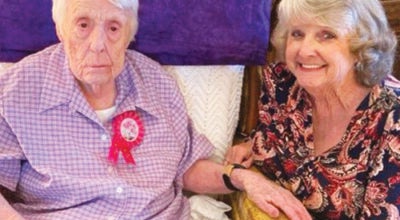Presidential sites: Thomas Jefferson’s Monticello one of most visited
Published 9:46 am Thursday, December 30, 2021
|
Getting your Trinity Audio player ready...
|
By Betty Etchison West
For the Enterprise
One of the most interesting and beautiful presidential homes is only about 235 miles from Mocksville, North Carolina.
That is Monticello, which was the home of Thomas Jefferson, the third President of the United States. It is probably also the presidential home that more of you, the readers of these column, have visited than any other. If you have not visited Monticello, which is near Charlottesville, Va., and want to do so, you should call phone number 434-984-9822 and get information about the hours that the house is open to the public.
It was to the unfinished Monticello, which means “little mountain,” that Thomas Jefferson brought his bride, Martha Wayles Skelton Jefferson, on a cold night in 1772. Martha and Thomas were married for 10 years when she died at Monticello in 1782. During the 10 years that they were married, the Jeffersons had six children; only two of whom lived to adulthood.
Thomas Jefferson loved his wife deeply and said in his autobiography that their life at Monticello was “ten years of unchequered happiness.” When Thomas Jefferson’s wife died, he was so distraught that he shut himself in his room for three weeks and he would walk the floor until he was totally exhausted. After Martha’s death, Jefferson never married again. Monticello remained his home until he died.
When Jefferson brought his bride to Monticello, it was not finished, and actually it was never really finished as far as Jefferson was concerned. He was always tearing something down and rebuilding it. He was a perfectionist.
If a wall was the slightest fraction of an inch off from the plan which he had drawn, that wall had to be torn down and rebuilt.
Visitors to Monticello during Jefferson’s lifetime said that you always could hear hammering and sawing because Jefferson was either tearing something down or building something.
You see, Thomas Jefferson was not only a politician, a statesman, and a farmer, but he was also an architect. Upon arriving at Monticello today, one is almost awe struck by the beauty of the place that Thomas Jefferson created. Visitors will probably agree the Thomas Jefferson was indeed an outstanding architect. The design of the house is outstanding and the grounds are well-groomed and attractive.
The authors, Nancy and Christopher Benbow, in their book “Cabins, Cottages and Mansions, Homes of the President of the United States” inform the reader that Monticello has 21 rooms. They describe the house as follows: “The house has three stories with nine upstairs bedrooms and a dome room, all reached by steep narrow steps. These narrow stairs are so designed because of Mr. Jefferson’ aversion to wasting space, but their danger to modern visitors has resulted in the marking of the second and third floors as off-limits to the public.”
Upon entering the Entrance Hall, you see the vast interest of the original owner of the house. In that area, you will see some of flora and fauna that was sent to the President by the explorers, Lewis and Clark. Jefferson not only wanted to know about the land that lay west of the Mississippi but also about the plants and animals. The explorers tried to provide the information that the President wanted by sending the many specimens. Also there is an interesting clock in that room. It is a seven day clock, which has an indoor and an outdoor face. Jefferson simply cut a hole in the floor so the weights could move down to complete the seven day cycle. There are also interesting portraits and busts in the Entrance Hall
Next the visitor will move into is the Library or “Book Room” as Jefferson called it. Jefferson is believed to have owned 7,000 volumes. Only a few of the books displayed there now belonged to Mr. Jefferson but the other books are titles which would have been found there in Jefferson’s time. The books show the interest of the man who could speak six languages.
From the library the visitor will see the South Piazza, which was Jefferson’s greenhouse. Mr. Jefferson’s cabinet or study is usually the next room on a tour of Monticello. It is one of the most interesting rooms because some on the former President’s inventions are in that room.
One of the most interesting a polygraph, which made duplicates of the letters written by Mr. Jefferson. The polygraph had two pens which would make two copies at one time. This must have been important to the former president who wrote over 19,000 letters.
The bench where Jefferson propped up his aching legs is there, as are a number of other interesting objects.
Mr. Jefferson’s bedroom is beside the study. The bed is built into the wall between the study and the bedroom. Mr. Jefferson could get into his bed from either room.
Then there is the parlor, where important family events occurred: weddings, christenings, etc. That is where Mr. Jefferson enjoyed the music of the harpsichord, which was played by his wife until her death and then by his daughter while he played the violin. There are many important works of art in the parlor.
The dining room and adjoining tea room were important to Mr. Jefferson. He loved good food, good wine and good company and he spent large amounts of money for food and wine.
The is much that was different about Monticello, but one thing that was very different from most early plantations was that the dependencies; that is the kitchen, laundry, wood spinning room, weaving room, etc. and even the slave quarters were attached to the main house by an all-weather passageway.
Before you leave Montello, explore the grounds and visit the Jefferson Cemetery which is not too far from the house. There lies body of the third President of the United States; however, his tombstone does not indicate that he was ever President. On a large granite tombstone the inscription simply says: “Author of the Declaration of the Independence and of the Statue of Virginia for religious freedom & Father of the University of Virginia.”
If you have time, visit the other house which was built by the third president, at the Poplar Forest Plantation. Having so much company finally “got to” Mr. Jefferson and he decided to build a “get-away house.” We therefore have the beautiful house at the Poplar Forest Plantation. That 5,000-acre plantation that was inherited by Jefferson’s wife, Martha, and became Mr. Jefferson’s property after his wife’s death. The Popular Forest Plantation was/is located about 90 miles from Monticello.
The Benbows’ in their book, Cabins, Cottages, & Mansions, describes the Poplar Forest house thusly: “Poplar Forest became one of the earliest octagonal homes in America, Its central room, a dining room, was originally a 20 foot cube. To illuminate the central room, Mr. Jefferson proposed a skylight stretching across the roof from east to west to measure …..16 feet 4 inches long by 3 feet 6 inches wide. Today, a low celling installed to create additional space has blocked the skylight. An original fireplace still stands, supported by a brick arch reaching down into the wine cellar directly under the dining are.”
Around that huge dining room is a number or odd shaped bedrooms: a study, a parlor, etc. The size of the large dining room indicates how important Mr. Jefferson considered dining.
When Mr. Jefferson grew weary of having too many guests at Monticello, he would have a servant bring a carriage into which he would load his favorite books, maybe a grandchild or two, and a couple of servants, and would escape to Poplar Forest. The Poplar Forest property had fertile land and probably helped Mr. Jefferson financially because it produced a great deal of tobacco and wheat.
The Poplar Forest mansion had a number of owners through the years and it was badly in need of repair or restoration. It is now owned by the Corporation for Jefferson’s Poplar Forest and it is being restored. The house has a few pieces of furniture but it is really not furnished. The docent there said that it probably will never be completely furnished.
Popular Forest is certainly another interesting presidential site to visit, but, again before you visit, call. The telephone number is 434-534-8120.



